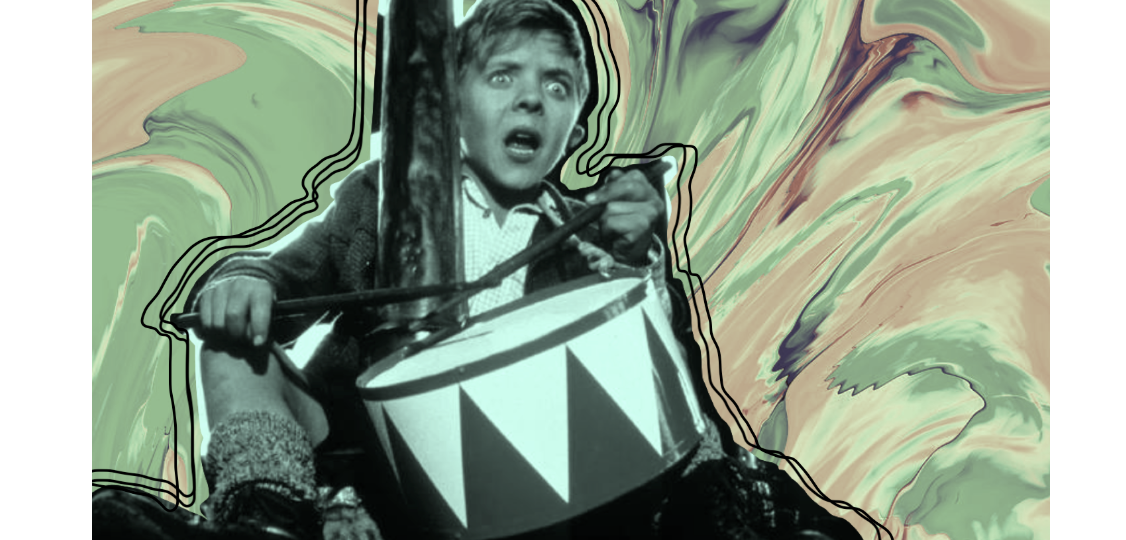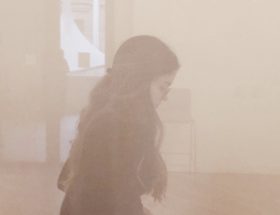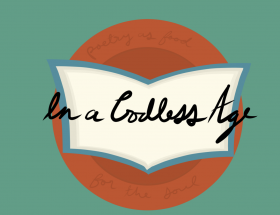Gunter Grass’s The Tin Drum was written to speak to a generation of guilt-stricken Baby Boomers reveling in the German Miracle following the Second World War. Similarly to the way noises simulate the spontaneity of jazz within the 1920’s in T.S. Eliot’s ‘The Wasteland’, it carries a defined musicality for those who read it. This rhythm speaks not to the barren hearts of the Lost Generation as Eliot did in (what is arguably) his magnum opus, but rather to the madness and emotions that overflowed from the minds of a world that had experienced the true insanity of the first half of the 20th century.
Oskar Matzerath, the protagonist of the novel is a man who willingly captures himself in the body of a three-year-old child, a mad genius unwilling to follow in the beat of anyone else’s drum (quite literally, he carries a tin drum with himself everywhere). He defines himself as an aesthete, a model, and the spitting image of the grotesque trends of 20th-century art that spoke more to its contemporaries than the classical beauty that inspired Western artists for millennia beforehand. He simultaneously acts as a symbol and a character. He stands on the cusp between the great modernists of the first half of the century and those that brought the world the disjointed contemporary aesthetic of the second half.
Olfactory description and experience, installation, craft, and music are part of the aesthetic experience set out by Grass. He places emphasis on catharsis as an essential part of art, as an experience to be felt with every bit of one’s senses, to invade the souls of those in pain and joy. The magic realism of The Tin Drum gives it a pass to be as direct as it likes, depicting catharsis in acts of extreme violence or plain absurdity throughout.
This novel draws on the grotesque as an expression of art felt purely, what exists when a masterpiece is stripped bare, left only with the truest human experience. It points so directly to our souls that Grass labels it “the shattered image of humanity, an accusation, a challenge, a timeless expression of the madness of our century” in describing Oskar through the eyes of a fictional art professor. He calls for his art students to nail him to a cross and violate the innocence of the “virgin white paper” laid out before them with black charcoal, to slaughter Oskar’s image however possible.
This overt violence and accusation are described by Grass as an inherent part of 20th-century artistic innovation. Whether this is pertinent in the 21st century is another matter altogether. Present Generation Z and Generation Y have found themselves similarly to Oskar in a time of transition. Times are changing and now, being on the brink of the second decade of the newer century, artistic expression has taken on a myriad of different qualities while also fundamentally retaining more than a few of those of the 20th century.
Oskar as an artist of the 20th century remains unapologetically himself, but exists in the context of a society that drowns itself in constant apologies, shame, and guilt. His mind is a representation of apologetic and unapologetic extremes, but to the outside world, he appears a stumbling child inharmoniously beating a little tin drum, trying to find himself employing all means possible to do so. The adolescence of revolutionary artistic expression is embodied in his character and the way that he responds to his environment. He weeps alongside a burdened post-Hitler Germany and uses art to do so while simultaneously employing it to gain vision and identity himself.
Today’s generations find themselves offbeat to the rhythm of the generations of the 60’s who solely defined revolution as overthrowing their colonial, patriarchal masters in order to gain sovereignty. The 21st century has come to recognize the lack of vision these adolescent revolutionaries had believing that this was possible in a world that maintained the power structures they struggled against in the first place. Artistic expression has found its place in building a new world, all the while apologizing for the mistakes of its past. Art in the present century has learned from its predecessor to continue to strive for an identity it sorely lacks, retaining the heart and determination demonstrated by Oskar in searching for his own beat in ‘TheTin Drum’.
It could be derived that the grotesque aesthetic depicted in the novel demonstrates a true break-in Western artistic expression that was a cornerstone of the 20th century. This would come to shatter the standards of beauty, skill, prestige, and far more accurately stood for the intensity of experiencing the world in a new day and age. Art made the unfathomable now fathomable, tangible, accessible through a whole new variety of means, some of which Oskar uses throughout the novel (including but not limited to onions, screaming, the circus, pillboxes, etc.). As a tool, artistic expression gave the voiceless a newfound space in society to depict the insanity of what they experienced in the so-called ‘Age of Extremes’.
The 21st century far more radically seeks to break walls and build a whole new space in which there is no distinction between the voiceless and those with a voice in the first place. Art in this century accuses the past as the 20th century once did, but in a far more revolutionary form seeks to smash the framework its ancestors attempted to overthrow by instead building a new world altogether. Oskar, his drum, and his grotesque expression created precedent as well as a wave of change based on extreme emotions which would eventually move later generations, not toward taking steps forward but instead, much-needed steps outside of the box. Artistic expression is creating its new forms of revolution, in a way proving art and change to be one and the same in this day and age. It proves art to be significant in constructing a new world altogether, and perhaps the most important feature of a future of which we can all form part.




